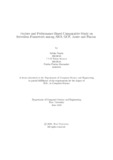| dc.contributor.advisor | Noor, Jannatun | |
| dc.contributor.author | Nasrin, Sabiha | |
| dc.contributor.author | Sahryer, T I M Fahim | |
| dc.contributor.author | Mazumder, Partha Pratim | |
| dc.date.accessioned | 2021-10-10T03:56:06Z | |
| dc.date.available | 2021-10-10T03:56:06Z | |
| dc.date.copyright | 2021 | |
| dc.date.issued | 2021-06 | |
| dc.identifier.other | ID 20141043 | |
| dc.identifier.other | ID 20141044 | |
| dc.identifier.other | ID 16301141 | |
| dc.identifier.uri | http://hdl.handle.net/10361/15183 | |
| dc.description | This thesis is submitted in partial fulfillment of the requirements for the degree of Bachelor of Science in Computer Science and Engineering, 2021. | en_US |
| dc.description | Cataloged from PDF version of thesis. | |
| dc.description | Includes bibliographical references (page 48-50). | |
| dc.description.abstract | Cloud computing is one of the most flourishing technologies in today’s internet based
world and the upcoming trend for the future. It has roughly been a decade of the
development on this field. The first initiative had been taken by the world class
companies like Amazon, IBM, Microsoft, Google etc. And in a matter of time the
average companies, brands and enterprises has adopted this revolutionary technology by building their own cloud platform. One of the very recent technology of cloud
is the serverless technology. Here the server side management is conducted by the
cloud providers and the clients’ only need to deploy their codes once in the server.
This system prevents a great deal of unessential consumption of power and is a Payas-you-go service. This technology has added a great impact on the software and
application development. But the major obstacle to this development field is that
there are not enough documentation on how the big companies provide this facility
and how their architecture is build. However many developers can not decide suitable platform for their required application. Also documentation on privately built
serverless architecture is not available. This can be done through massive documentation on comparison and evaluation on the existing cloud platforms on which the
companies can run their own serverless applications and embrace the hybrid world.
Therefore, our research purpose is to focus on the serverless architecture of the existing platforms. A comparative study with necessary measures can be effective and
efficient to use for further serverless implementation. So, we and others can follow
our research for understanding the technical complexity. We will emphasize on the
actual characteristics of serverless throughout our work. Furthermore, our goal is
to come up with effective analogy on how different serverless platforms behaves in
different Use cases. | en_US |
| dc.description.statementofresponsibility | Sabiha Nasrin | |
| dc.description.statementofresponsibility | T.I.M. Fahim Sahryer | |
| dc.description.statementofresponsibility | Partha Pratim Mazumder | |
| dc.format.extent | 90 pages | |
| dc.language.iso | en | en_US |
| dc.publisher | Brac University | en_US |
| dc.rights | Brac University theses are protected by copyright. They may be viewed from this source for any purpose, but reproduction or distribution in any format is prohibited without written permission. | |
| dc.subject | Serverless | en_US |
| dc.subject | Docker | en_US |
| dc.subject | Virtual Machine | en_US |
| dc.subject | AWS Lambda | en_US |
| dc.subject | GCP | en_US |
| dc.subject | Azure | en_US |
| dc.subject | Kubernetes | en_US |
| dc.subject | Fission | en_US |
| dc.subject | Comparison analysis | en_US |
| dc.subject | Load balancing | en_US |
| dc.subject | Elasticity | en_US |
| dc.subject.lcsh | Virtual machine manager | |
| dc.subject.lcsh | Elasticity | |
| dc.title | Feature and performance based comparative study on serverless framework among AWS, GCP, azure and fission | en_US |
| dc.type | Thesis | en_US |
| dc.contributor.department | Department of Computer Science and Engineering, Brac University | |
| dc.description.degree | B. Computer Science | |

